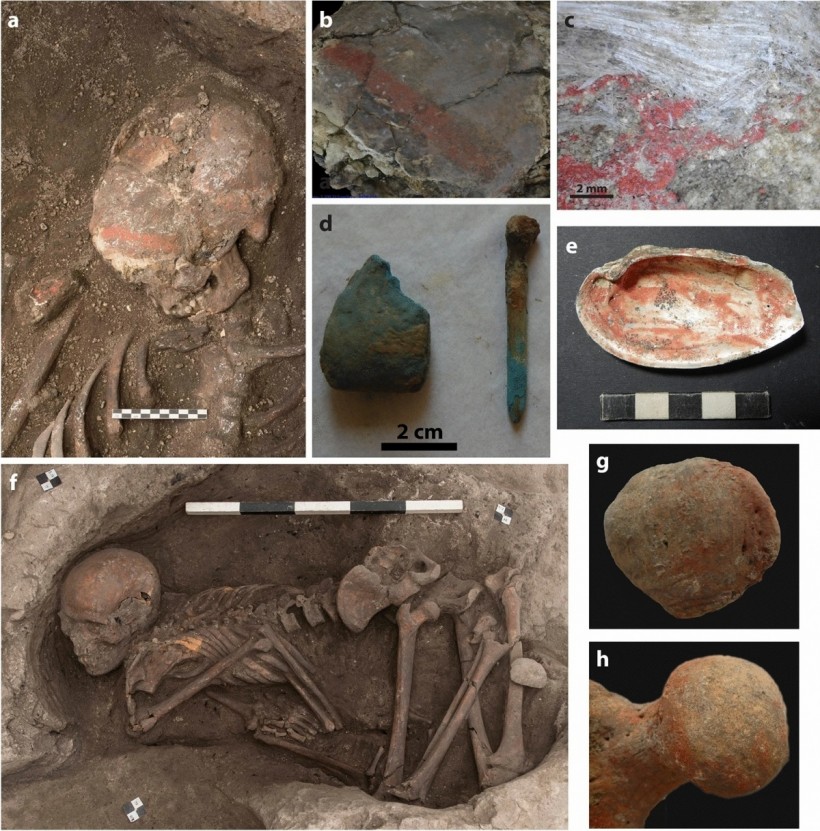One of the oldest human settlements, located in ancient Catalhoyuk, was discovered with a fascinating practice given to the remains of their community members. According to a new study, they relay colorful artworks to the bones of their dead.
Catalhoyuk: Ancient City in Turkey

Examples of funerary pigment use at Çatalhöyük. (a) In situ photograph from skeleton 32818 with cinnabar stripe and a shell with cinnabar deposited at the right shoulder (Photograph by J. Quinlan); (b) Detail of the cinnabar stripe (Photograph by M. Milella); (c) Microscopic image of the frontal bone of skeleton 22196 showing a cinnabar layer with unstained phytoliths on top (Photograph by E. Schotsmans); (d) Bone ‘applicator’ with lump of blue pigment recovered with skeleton 16308 (Photograph by J. Quinlan); (e) Unio shell ‘palette’ with cinnabar (22194.X6) (Photograph by R. Veropoulidou); (f) Individual 21884 was buried on its right side with the skeletal elements on the uppermost and left side of the skeleton more intensely stained with red pigment (Photograph by J. Quinlan); (g) Right patella of skeleton 21884 was more stained on its medial side (Photograph by E. Schotsmans); (h) The partial discolouration of the left femoral head confirms that individual 21884 was flexed and fleshed when the ochre was applied, leaving the main part of the femoral head unstained (Photography by E. Schotsmans).
Catalhoyuk, a bountiful place of the past, was located in modern-day Turkey. Among the first established civilizations, historians consider Catalhoyuk the first-ever successful early city.
The precursor of the modern metropolis existed 9,000 years ago during the Neolithic age. The city dominated nearby settlements in the peninsula of ancient Anatolia, stretching communities that included more than 8,000 of the region's population.
The progressive city of Catalhoyuk was founded in approximately 7100 BC. Although many discoveries from the ancient civilization mirrored the things and practices we have in the modern world, Catalhoyuk also contains many aspects that significantly contrast cities today.
Among the bizarre details that previous studies observed from the place is that Catalhoyuk did not contain any streets. The settlers' infrastructures that served as habitats were built directly beside each section. The only way to get in and out of the homes was to climb to the rooftop.
Science Alert reports that Catalhoyuk homes are not lonely, as people of the city bury their dead right inside their own houses, right beneath their floors.
Université de Bordeaux Laboratoire d'Anthropologie des Populations Passées et Présentes (PACEA) expert and lead author of the study Eline Schotsmans explained that remains of adult bodies are commonly placed in the northern and eastern platforms of the home's central room, in which they are arranged in a flexed position.
Remains of other bodies that belong in separate age groups such as perinate, neonate, and infants are placed in different locations than the central part of the house.
Alongside the burial method, the citizens of Catalhoyuk paint the remains of their dead ones as part of a ritual before sending the bodies to their graves.
Catalhoyuk City's Bizarre Burial Ritual
In the new study, experts analyzed the skeletal remains of previous Catalhoyuk citizens. The sets of bones came from 800 individuals that have been unearthed from the original spots since the 1990s. The analysis of the bones and the pigments utilized for the artworks was made possible through the help of an X-ray fluorescence spectrometer.
About six percent of the total skeletons were found to have pigments applied to them directly. Eleven percent had objects on their graves that matched the utilized pigments on the bones. The colored materials included bowls, shells, baskets, and even bone pieces.
Skeletal remains were normally painted with a red pigment, and more men than women had the paint. The red color was identified to exist frequently in the cranium of the people, with ochre as the compound for the shade.
Males had more mercury sulfide or cinnabar painted on their bones. Blue and green pigments in the burial objects were exclusive for children and females. As to why specific colors are used to the remains and objects, experts suspect symbolism for developmental growth and fertility, but the real meaning behind the ritualistic burial remains unsolved.
The study was published in the journal Scientific Reports, titled "New insights on commemoration of the dead through mortuary and architectural use of pigments at Neolithic Çatalhöyük, Turkey."
RELATED ARTICLE: Ancient Tombs Hidden Under Notre Dame Paris, Excavated with Well-Preserved Coffins, Ancient Artifacts
Check out more news and information on Archaeology in Science Times.










!['Cosmic Glitch' in Einstein's Theory of General Relativity Could Be Explained in This New Scientific Tweak [Study]](https://1721181113.rsc.cdn77.org/data/thumbs/full/53435/258/146/50/40/cosmic-glitch-in-einsteins-theory-of-general-relativity-could-be-explained-in-this-new-scientific-tweak-study.jpeg)



